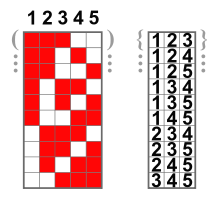A-level Mathematics/CIE/Pure Mathematics 1/Series
The Binomial Theorem
[edit | edit source]Before we discuss the binomial theorem, we need to discuss combinations. In order to discuss combinations, we need to discuss factorials.
Factorials
[edit | edit source]The factorial of a number is the product of all numbers from 1 to that number. It is represented by the symbol after the number.
e.g.
The factorial can be formally defined as:
Combinations
[edit | edit source]
Combinations are a way of calculating how many ways a set of items with a given size can be selected from a larger set of items. It is typically represented either by the column notation or by the notation .
Combinations can be calculated using factorials: .
e.g.
The Binomial Theorem
[edit | edit source]The binomial theorem is used when we need to raise a binomial, an expression consisting of two terms, to the power of a given , e.g. .
The binomial theorem states that
e.g.
The binomial theorem is sometimes summarised as
Arithmetic Progressions
[edit | edit source]An arithmetic sequence is a progression in which the numbers increment by a fixed quantity from one term to the next.
e.g. is an arithmetic sequence (the fixed quantity is )
The nth term
[edit | edit source]The nth term of an arithmetic sequence can be determined using where is the nth term, is the first term, and is the difference between two consecutive terms in the progression.

e.g. The sequence has a difference of . So the nth term of this sequence can be determined by . Thus, if we wanted to find the 1000th term of the progression, we can use the nth term formula: .
Sum of the first n terms
[edit | edit source]The sum of the first n terms of an arithmetic progression can be found using the formula:
e.g. Find the sum of the first 50 terms of the sequence
Geometric Progressions
[edit | edit source]A geometric progression is like an arithmetic progression except that instead of adding a constant from one term to the next, we multiply each term by a constant to get the next term.
e.g. is a geometric sequence.
The nth term
[edit | edit source]The nth term for a geometric progression is given by where is the nth term, is the first term, and is the ratio between two consecutive terms.
Sum of the first n terms
[edit | edit source]
The sum of the first n terms of a geometric series can be found using .
e.g. The sum of the first 10 terms of the sequence is .
Convergence
[edit | edit source]A convergent geometric progression is one where the terms get smaller and smaller, meaning that as approaches infinity, the th term approaches zero. An important consequence of this is that the progression will have a defined sum to infinity.
We can tell if a sequence is convergent if the ratio is less than and more than . If this condition is not satisfied, the sequence is divergent.
Sum to Infinity
[edit | edit source]The sum to infinity of a geometric progression is the value that the sum of the first terms as approaches infinity. If a progression is convergent, its sum to infinity will be finite.
The sum to infinity is given by which is equivalent to if .
e.g. The sum to infinity of the sequence is




































